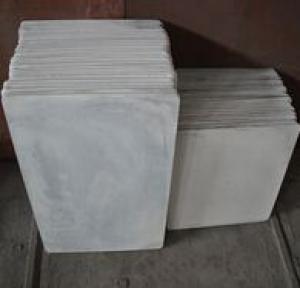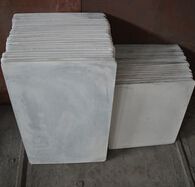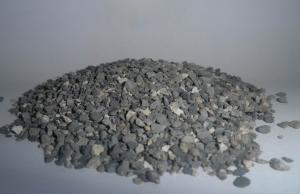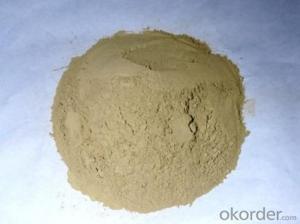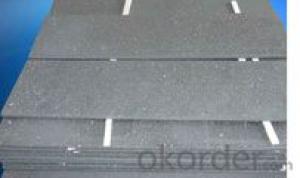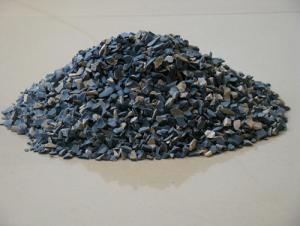Raw Materials for Sintered Silicon Nitride Bonded SiC Refractory Plate
- Loading Port:
- China Main Port
- Payment Terms:
- TT OR LC
- Min Order Qty:
- -
- Supply Capability:
- -
OKorder Service Pledge
OKorder Financial Service
You Might Also Like
Specifications
Sintered silicon nitride bonded SiC refractory plate
1.Density:2.65g/cm3
2.Max temperature:1700C
3.Bending strength:>45Mpa
Silicon Nitride (Si3N4) bonded silicon carbide (SiC) material is a new type of advanced refractory materials. Compared with silicon carbide product, the product has characteristics of small thermal expansion, high thermal conductivity, not easy to have thermal stress, good thermal shock resistance, corrosion resistance, extreme cold or heat, oxidation, high temperature creep resistant ability and easily made into products with high dimensional accuracy requirements in line. Silicon nitride combined silicon carbide products have very high strength for normal atmospheric temperature, and it remains almost the same time with the strength and hardness at high temperature 1200-1400C. with the difference of using atmosphere, the maximum safe operating temperature could reach 1650-1750C.
Ceramic kiln shelf,panels,pillars,seperated flame plate,Waste Incineration Furnace Lining,aluminum tank.
All products are produced to the highest quality standards which means the consistent supply of ceramic components to enable your process to run more efficiently.
All components are supplied with a replacement guarantee. This guarantee provides for the replacement of the component if the service life is reduced because of a fault in the manufacturing process.
Typically we offer a guarantee of 40 days life in service for a riser tube in a low pressure aluminum die casting application, depending on the design. Our experience has shown that the design of the riser tube has an effect on the operational life. We can call on our experience and advise on the design of components to ensure the longest possible life for ceramic parts in your equipment.


- Q: What is refractory brick?
- Capability1. Refractory brick is also known as firebrick. It is faint?yellow or brownish. Refractory brick with 770 ℃ at high temperatures is called for short firebrick. It is mainly used for building and smelting furnace. It is a refractory material made by fring refractory clay or other refractory material.
- Q: How to use fire-resistant soil?
- Clay refractory soil 1, characteristics and uses: Clay refractory brick is a weak acid refractory material, its thermal stability is good, suitable for hot air furnace, all kinds of boiler lining, and flue, smoke room, etc.. 2, product specifications form: standard shape, general, special-shaped and special-shaped brick. Physical and chemical properties of fireclay bricks.
- Q: Refractory material, refractory brick
- Refractory materials of various varieties, different uses, it is necessary to scientifically classify refractory materials, so as to facilitate scientific research, rational selection and management. There are many classification methods for refractory materials, among which chemical properties classification method, chemical mineral classification method, production technology classification method, material form classification method and so on are included.
- Q: What's the poured refractory material?
- According to the volume density, it can be classified as follows: Heavy (>2.0g /cm3), medium heavy (1.0-2.0g/cm3), light (0.4-1.0g/cm3); classified by binding agent: hydraulic bond, chemical bond, coagulation binder, hydraulic and coagulation binder; classified by material: material of clayey, high alumina, silicious, magnesian, alumina-magnesia, magnesian-chrome, magnesia-zirconia, silicon carbide-based, etc.
- Q: How long is the duration of fire resistance that fireproof door of level B can endure?
- The national standard for fireproof door of level B is 1.5h, which must be achieved. The data GB12955-2008 means that the door leaf of raw material is 0.8mm-1.2mm in thickness and door frame is 1.2mm-1.5mm in thickness. And other metal melting temperature shall not be less than 950℃, the duration of fire resistance shall not be less than 0.9 hours. Fire department will check and accept based on the manufacturer's inspection report, so you have to refer to manufacturer's inspection report if you want to know more in detail.
- Q: What are the chemical composition of refractory cement?
- Calcium aluminate prepared by calcining as the main component. Aluminate cement takes bauxite and limestone as raw materials, alumina content of about 50% as the clinker. And it is a hydraulic cementing material made by grinding. Refractory cement is also known as aluminate cement.
- Q: The performance of refractory material
- As for easticity modulus, you can serach for information on the Internet or specialized books.
- Q: What are the new types of refractories? What are the characteristics? Their applications and developments?
- Special materials often use AZS brick, corundum brick, magnesia chrome brick, silicon carbide, silicon nitride bonded silicon carbide, nitrides, silicides, sulfide, boride, carbide and other non oxide refractory materials; calcium oxide, chromium oxide, alumina, Magnesium Oxide, beryllium and other refractory materials. Often used insulation refractories are diatomite products, asbestos products, insulation panels and so on. Unshaped refractory materials commonly used are fettling, refractory ramming material, refractory castable, refractory plastic material, refractory clay, refractory gunning, refractory cast material, fireproof coating, lightweight castable, mud etc..
- Q: What's meaning of CN of fire-resistant material?
- The commonly used preparation methodsinclude shock compression, high-pressure pyrolysis, ion implantation, reactive sputtering, plasma chemical vapor deposition, electrochemicaldeposition, ion beam sputtering, , low-energy ion radiation, pulsed arc discharge,pulsed laser inducing, etc. But the compounding result of superhard materialis not ideal due to deposition of amorphous CN film, nanometer level sizedC3N4 crystalline grain set in the amorphous film and few large graincrystal.
- Q: Who knows what fire heat preservation material are there?
- Organic material, polystyrene board, plastic extruded board, phenolic resin. Sea capacity module (fire insulation materials fire performance can reach the B1 level, thermal conductivity is only 0.028w\m - K is a good choice, class A fireproof materials now is the mainstream rock wool (mineral wool is wool). A1 fire resistance The largest manufacturer is Thai stone rock wool Co. Ltd.
Send your message to us
Raw Materials for Sintered Silicon Nitride Bonded SiC Refractory Plate
- Loading Port:
- China Main Port
- Payment Terms:
- TT OR LC
- Min Order Qty:
- -
- Supply Capability:
- -
OKorder Service Pledge
OKorder Financial Service
Similar products
Hot products
Hot Searches
Related keywords
